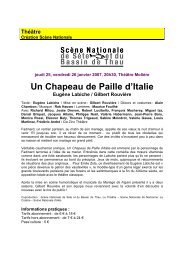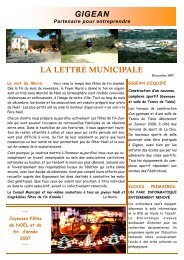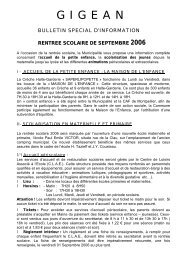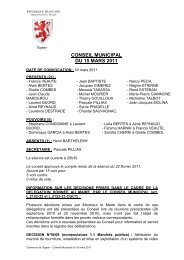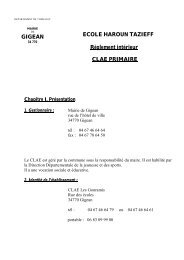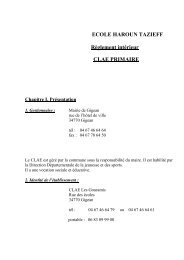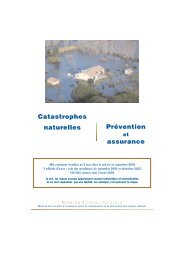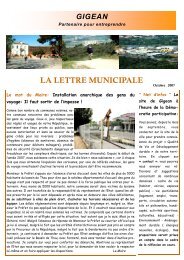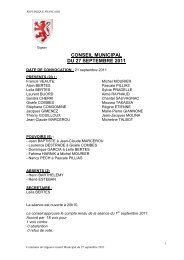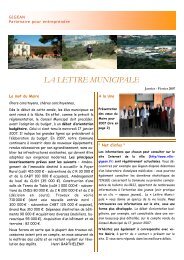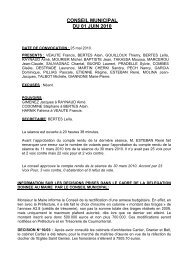LES CATASTROPHES NATURELLES EN FRANCE - Ville de Gigean
LES CATASTROPHES NATURELLES EN FRANCE - Ville de Gigean
LES CATASTROPHES NATURELLES EN FRANCE - Ville de Gigean
You also want an ePaper? Increase the reach of your titles
YUMPU automatically turns print PDFs into web optimized ePapers that Google loves.
Septembre 2004 - September 2004<strong>LES</strong> <strong>CATASTROPHES</strong> NATUREL<strong>LES</strong> <strong>EN</strong> FRANC<strong>EN</strong>atural disasters in France
LE RÉGIME D’INDEMNISATIONDES <strong>CATASTROPHES</strong> NATUREL<strong>LES</strong>The natural disastercompensation scheme04040708090708091112111213Avant la loi <strong>de</strong> 1982Prior to the 1982 lawLe fonctionnementdu régime d’in<strong>de</strong>mnisationLa genèse <strong>de</strong> la loi du 13 juillet 1982Les conditions <strong>de</strong> mise en jeu <strong>de</strong> la loiLes biens garantisLes périls couvertsL’étendue <strong>de</strong> la garantieLes franchisesLa tarificationHow the compensation scheme worksOrigin of the Law of 13 July 1982Conditions for the Law to operateProperty insuredPerils insuredExtent of coverDeductiblesRates of premiumLe rôle du BureauCentral <strong>de</strong> TarificationQu’est ce que le BCT ?Bases législatives et réglementairesdu BCT Catastrophes NaturellesCompositionProcédures <strong>de</strong> saisine du BCT “Cat’Nat’”Rappel <strong>de</strong>s cas <strong>de</strong> dispense<strong>de</strong> garantie <strong>de</strong> l’AssureurThe role of the BureauCentral <strong>de</strong> TarificationWhat is the BCT?Legislative and regulatory basisof the BCT Natural DisastersCompositionProcedures for referring a matterto the “Natural Disasters” BCTRemin<strong>de</strong>r of instances where the insureris not required to provi<strong>de</strong> coverLa procédure d’in<strong>de</strong>mnisationLe réglement du sinistreObligations <strong>de</strong> l’assuréObligations <strong>de</strong> l’assureurCompensation procedureSettlement of lossDuties of the InsuredInsurer’s obligationÉvolution du systèmeAu niveau <strong>de</strong> la CommissioninterministérielleAu niveau du marché <strong>de</strong> l’assuranceAu niveau législatifGrowth of the schemeAt Interministerial Commission levelAt the insurance market levelAt the legislative levelLa réassurance<strong>de</strong>s catastrophes naturellesLe système mis en place par la CCRLes différents aménagements du schéma<strong>de</strong> réassurance <strong>de</strong> la CCRLes modalités <strong>de</strong> réassurance 2000L’évolution <strong>de</strong>s cessions à la CCRReinsurance of natural disastersCCR’s schemeThe various amendments to the CCRreinsurance schemeReinsurance in 2000Changes in cessions to CCRConclusionL’originalité du système françaisConclusionThe originality of the french system141417192217192324262829242628293030
0405AVANT LA LOI DE 1982Prior to the 1982 lawGuyane, 20.04.2000Glissement <strong>de</strong> terrain.Guyana, 04.20.2000Landsli<strong>de</strong>.Les événements naturels (inondations, séismes,raz-<strong>de</strong>-marée, éruptions volcaniques, etc.) étaientautrefois traditionnellement exclus <strong>de</strong>s contratsd’assurances.Cette absence <strong>de</strong> couverture avait trois causesprincipales :• l’absence <strong>de</strong> statistiques fiables sur ce type <strong>de</strong>phénomènes,• un risque important <strong>de</strong> cumul (un mêmeévénement pouvant toucher un grand nombred’assurés, l’engagement <strong>de</strong> l’assureur est difficileà cerner),• un risque d’antisélection (seules les personnesexposées contractent une assurance).Natural phenomena (flood, earthquake, tidalwave, volcanic eruption, etc.) were traditionallyexclu<strong>de</strong>d from insurance policies.There were three main reasons for this lack ofcover:• absence of reliable statistics regarding this typeof phenomena,• serious accumulation risk (a single event couldaffect large numbers of insureds, insurers’exposure is hard to assess),• anti-selection risk (only those exposed purchaseinsurance).
0607LE FONCTIONNEM<strong>EN</strong>TDU RÉGIME D’INDEMNISATIONHow the compensation scheme worksCuxac-d’Au<strong>de</strong>, 13.11.1999Vue aérienne après les inondationsdu Sud-Est <strong>de</strong> la France.Cuxac-d’Au<strong>de</strong>, 11.13.1999Floods Sud-Est of France.La genèse <strong>de</strong> la loidu 13 juillet 1982Les premières réflexions sur la mise en place d’unrégime couvrant les dommages causés par <strong>de</strong>sphénomènes naturels se firent au cours <strong>de</strong>s annéessoixante-dix. La CCR y participa mais le projet futabandonné. Les étu<strong>de</strong>s reprirent au début <strong>de</strong>sannées quatre-vingt avec un projet <strong>de</strong> création<strong>de</strong> fonds public (plusieurs propositions <strong>de</strong> loifurent déposées en ce sens).Fin 1981, d’importantes inondations survinrentdans les vallées <strong>de</strong> la Saône et du Rhône et dansle Sud-Ouest <strong>de</strong> la France. Le projet <strong>de</strong> fondspublic, alors en cours d’examen, évolua vers celuid’un système mixte, faisant appel à la fois à l’Étatet à l’assurance. C’est ce <strong>de</strong>rnier projet qui a aboutià la loi du 13 juillet 1982.Les conditions<strong>de</strong> mise en jeu <strong>de</strong> la loiToute in<strong>de</strong>mnisation au titre <strong>de</strong> la loi <strong>de</strong> 1982 estsubordonnée à <strong>de</strong>ux conditions préalables quidoivent être impérativement remplies :• l’état <strong>de</strong> catastrophe naturelle doit avoir étéconstaté par un arrêté interministériel,• les biens sinistrés doivent être couverts par uncontrat d’assurance “dommages aux biens”.Bien entendu, un lien <strong>de</strong> causalité doit existerentre la catastrophe constatée par l’arrêté et lesdommages subis par l’assuré.Les biens garantisSont couverts, les immeubles et meubles (y comprisvéhicules terrestres à moteur) assurés contre lesdommages d’incendie ou tout autre type <strong>de</strong>dommage (vol, dégâts <strong>de</strong>s eaux, etc.).Exceptées la tarification et les franchises, la garantie<strong>de</strong>s catastrophes naturelles n’a pas <strong>de</strong> conditionsqui lui soient propres. Elle suit celles <strong>de</strong> la garantie<strong>de</strong> base du contrat (le plus souvent, la garantieincendie), et couvre donc généralement :• les habitations et leur contenu,• les installations industrielles et commerciales etleur contenu,• les bâtiments appartenant aux collectivités localeset leur contenu,• les bâtiments agricoles (y compris les récoltes,machines ou animaux se trouvant à l’intérieur<strong>de</strong>sdits bâtiments),• les serres considérées en tant que bâtiment oumatériel (à l’exclusion toutefois <strong>de</strong>s culturescontenues dans celles-ci),• les véhicules,• les accessoires et équipements automobiles sileur couverture est prévue dans la garantie <strong>de</strong>base,• les clôtures, murs <strong>de</strong> soutènement ou fondationss’ils sont couverts par le contrat,• éventuellement les forêts lorsqu’elles sontassurées par un contrat “dommages aux biens”,• les frais <strong>de</strong> déblai, <strong>de</strong> démolition, <strong>de</strong> pompageet <strong>de</strong> nettoyage.Origin of the Lawof 13 July 1982Initial consi<strong>de</strong>rations on the implementation of aprogramme covering losses caused by naturalphenomena were put forward in the seventies.CCR took part in this but the project wasabandoned. Deliberations started again in theearly eighties in the form of a project aimed atcreating a public fund (several bills were submittedto parliament to this effect).At the end of 1981 serious floods occurred in thevalleys of the Saône and Rhône and in the South-West of France. The project for a public fundwhich was being consi<strong>de</strong>red at this time, becamea mixed system, relying on both the State and onthe insurance industry. It is this last project whichresulted in the Law of 13 July 1982.Conditions for the Lawto operateAll compensation un<strong>de</strong>r the 1982 Law is subjectto two prior conditions being met:• <strong>de</strong>claration of the state of natural disaster byinterministerial <strong>de</strong>cree,• a “property damage” insurance policy mustcover the damaged property.Clearly, a causal link must exist between thecatastrophe <strong>de</strong>clared in the <strong>de</strong>cree and the damagesuffered by the insured.Property insuredBuildings and moveable property (including motorvehicles) insured against fire or any other type ofdamage (theft, water damage, etc) are eligible.Apart from the premium rate and <strong>de</strong>ductibles,natural disaster cover does not have its ownspecific conditions. It follows those of the maininsurance (in most cases fire insurance), andtherefore normally covers:• domestic property and its contents thereof,• industrial and commercial installations and itscontents,• buildings owned by local authorities and itscontents,• agricultural buildings (including crops, machineryor animals insi<strong>de</strong> such buildings),• greenhouses <strong>de</strong>emed to be buildings orequipment (but excluding crops insi<strong>de</strong> them),• vehicles,• car accessories and equipment if covered by thebasic insurance,• fences, supporting walls or foundations if theyare covered by the policy,• any forests which are covered un<strong>de</strong>r a “propertydamage” policy,• the cost of <strong>de</strong>bris removal, <strong>de</strong>molition, pumpingand cleaning.
0809LE FONCTIONNEM<strong>EN</strong>T DU RÉGIME D’INDEMNISATION - How the compensation scheme worksLes périls couvertsLe législateur n’a pas souhaité borner la loi <strong>de</strong>1982 en établissant une liste <strong>de</strong>s phénomènesnaturels garantis. Il n’a pas non plus fourni <strong>de</strong> listed’exclusions, se limitant à la notion <strong>de</strong> “dommagesnon assurables”, (cette notion a été précisée parles lois <strong>de</strong>s 25 juin 1990 et 16 juillet 1992 quiseront évoquées plus loin).De ce fait, l’énumération qui suit ne se veut pasexhaustive :• inondations et/ou coulées <strong>de</strong> boue,• séismes,• mouvements <strong>de</strong> terrain,• sécheresse géotechnique (mouvements <strong>de</strong> terraindifférentiels consécutifs à la sécheresse et à laréhydratation <strong>de</strong>s sols),• raz-<strong>de</strong>-marée,• ruissellements d’eau, <strong>de</strong> boue ou <strong>de</strong> lave,• masse <strong>de</strong> glace ou <strong>de</strong> neige en mouvement.Le dommage doit être “direct” c’est-à-diredécoulant exclusivement <strong>de</strong> l’action d’un agentnaturel d’intensité anormale sur un bien assuré(exemple : la perte <strong>de</strong> <strong>de</strong>nrées en congélateur nesera prise en charge que dans la mesure où cetappareil a lui-même été endommagé, ce qui exclutla simple coupure d’électricité).L’étendue <strong>de</strong> la garantie“La garantie couvre le coût <strong>de</strong>s dommagesmatériels directs subis par les biens à concurrence<strong>de</strong> leur valeur fixée au contrat et dans les limiteset conditions prévues par ce contrat lors <strong>de</strong> lapremière manifestation du risque” (arrêté du10 août 1982 - clauses types).L’extension <strong>de</strong> garantie “catastrophes naturelles”est également systématique pour les contratscouvrant la “perte d’exploitation”. Dans ce cas, elleprend en charge la perte <strong>de</strong> bénéfice brut et lesfrais supplémentaires d’exploitation pendant lapério<strong>de</strong> d’in<strong>de</strong>mnisation du contrat.Les sinistres sont réglés sur la base <strong>de</strong> la garantie“dommages” du contrat ayant la portée la plusétendue (exemple : la garantie incendie dans lescontrats “multirisques”).Les modalités d’in<strong>de</strong>mnisation sont i<strong>de</strong>ntiques àcelles <strong>de</strong> la garantie <strong>de</strong> base (exemple : règlementen valeur à neuf si cette extension est prévue dansla garantie <strong>de</strong> base).Les franchisesLe niveau <strong>de</strong>s franchises, qui sont non in<strong>de</strong>xées,a été fixé par l’arrêté du 10 août 1982. Il a, par lasuite, fait l’objet <strong>de</strong> plusieurs révisions (arrêtés <strong>de</strong>s7 et 19 septembre 1983 et arrêtés du 5 septembre2000). Depuis le 1 er janvier 2002, il s’établit commesuit :• biens à usage d’habitation, véhicules terrestresà moteur et autres biens à usage nonprofessionnel : 380 €, sauf en ce qui concerneles dommages imputables aux mouvements <strong>de</strong>terrain différentiels consécutifs à la sécheresseet/ou à la réhydratation <strong>de</strong>s sols (subsi<strong>de</strong>nce)pour lesquels le montant est <strong>de</strong> 1 520 €,• Véhicules terrestres à moteur : 380 € pourchaque véhicule endommagé (même si le contraten couvre plusieurs). Toutefois, pour les véhiculesà usage professionnel, sera appliquée la franchiseprévue par le contrat, si elle est supérieure à lafranchise légale,• biens à usage professionnel : 10 % dumontant <strong>de</strong>s dommages matériels directs parétablissement et par événement avec unminimum <strong>de</strong> 1 140 € sauf en ce qui concerneles dommages imputables aux mouvements <strong>de</strong>terrain différentiels consécutifs à la sécheresseet/ou à la réhydratation <strong>de</strong>s sols pour lesquelsle montant est <strong>de</strong> 3 050 €,• pertes d’exploitation : trois jours ouvrés avec unminimum <strong>de</strong> 1 140 € sauf lorsqu’une franchiseplus élevée est prévue dans la garantie <strong>de</strong> base.Perils insuredThe legislators did not want to limit the 1982 Lawby creating a list of the natural phenomenacovered. Nor did they want to create a list ofexclusions. They limited themselves, therefore, tothe i<strong>de</strong>a of “uninsurable damage” (this i<strong>de</strong>a wasthen clarified by the Laws of 25 June 1990 and16 July 1992, see below). The following list is,therefore, not exhaustive:• floods and/or mudsli<strong>de</strong>s,• earthquakes,• landsli<strong>de</strong>s,• geotechnical subsi<strong>de</strong>nce (differential landsli<strong>de</strong>sfollowing drought and rehydration of the soils),• tidal waves,• flows of water, mud or lava,• moving masses of ice or snow.The damage must be “direct”, in other wordsarising solely as a result of the action of a naturalelement of abnormal intensity to the propertyinsured (e.g.: the loss of goods in a freezer willonly be inclu<strong>de</strong>d if the machine itself wasdamaged, thus excluding a simple power cut).Extent of cover“The policy covers the cost of direct materialdamage suffered by the property up to the valuestated in the policy and subject to the terms andconditions of the said policy at the time the riskfirst occurs” (Decree of 10 August 1982 - StandardClauses).The “natural disaster” coverage is also exten<strong>de</strong>dto inclu<strong>de</strong> all “business interruption” policies. Inthis case, it covers loss of gross profit and additionaloperating costs during the in<strong>de</strong>mnity periodspecified in the policy.Claims are settled on the basis of the “damage”cover un<strong>de</strong>r the policy with the wi<strong>de</strong>st scope (e.g.:fire cover in “multiline” policies).In<strong>de</strong>mnity is provi<strong>de</strong>d in the same way as un<strong>de</strong>rthe basic cover (e.g.: settlement of on new-foroldbasis if this extension is inclu<strong>de</strong>d in the basiccover).DeductiblesThe <strong>de</strong>ductibles, which are not in<strong>de</strong>x-linked, werespecified by the <strong>de</strong>cree of 10 August 1982. Theyhave subsequently un<strong>de</strong>rgone several changes(Decrees of 7 and 19 September 1983 and <strong>de</strong>creeof 5 September 2000). With effect from 1 st January2002, the <strong>de</strong>ductibles are structured as follows:• property for domestic use, motor vehicles andother objects not inten<strong>de</strong>d for professional use:€ 380, except in the case of damage attributableto differential movements of the earth as a resultof drought and/or the rehydration of the soil(subsi<strong>de</strong>nce), where the <strong>de</strong>ductible is € 1,520,• motor vehicles: € 380 for each damaged vehicle(even if the insurance policy covers severalvehicles). However, for vehicles inten<strong>de</strong>d forprofessional use, the <strong>de</strong>ductible contained inthe basic cover shall apply if it exceeds thestatutory <strong>de</strong>ductible,• property for professional use: 10% of the directproperty damage loss for each and every locationand each and every loss occurrence, subject toa minimum of € 1,140, except in the case ofdamage attributable to subsi<strong>de</strong>nce, where the<strong>de</strong>ductible is € 3,050. If, however, the basiccover contains a higher <strong>de</strong>ductible, then thishigher <strong>de</strong>ductible shall apply,• business interruption: 3 working days subjectto a minimum of € 1,140, unless the basic covercontains higher <strong>de</strong>ductible.Par ailleurs, <strong>de</strong>puis le 1 er janvier 2001, unemodulation <strong>de</strong> ces franchises a été mise en placeafin d’inciter à la mise en œuvre <strong>de</strong> mesures <strong>de</strong>prévention. Elle est appliquée dans les communesnon encore dotées d’un plan <strong>de</strong> prévention <strong>de</strong>srisques naturels prévisibles (PPR).Concrètement, lors <strong>de</strong> la constatation, par arrêtéinterministériel, <strong>de</strong> l’état <strong>de</strong> catastrophe naturelledans une telle commune suite à la survenanced’un péril donné (une inondation par exemple), uncoefficient multiplicateur est appliqué à la franchiseen fonction du nombre d’arrêtés déjà pris pource même péril au cours <strong>de</strong>s cinq années précédantla date <strong>de</strong> la nouvelle constatation (arrêté du4 août 2003 du ministre <strong>de</strong> l’économie, <strong>de</strong>s financeset <strong>de</strong> l’industrie). Ces coefficients sont les suivants :• 1 à 2 arrêtés : application normale <strong>de</strong>s franchisesci-<strong>de</strong>ssus indiquées,• 3 arrêtés : doublement <strong>de</strong> ces franchises,• 4 arrêtés : triplement <strong>de</strong> ces franchises,• 5 arrêtés ou plus : quadruplement <strong>de</strong> cesfranchises.Cette modulation est suspendue dès la prescriptiond’un PPR pour le péril concerné mais elle estréactivée en cas d’absence d’approbation <strong>de</strong> cePPR à l’issue d’un délai <strong>de</strong> quatre ans. Elle n’est pasapplicable aux véhicules terrestres à moteur.Les franchises s’enten<strong>de</strong>nt par événement et parcontrat. Elles sont obligatoires, c’est-à-dire qu’elless’appliquent également lorsque le contrat <strong>de</strong> basen’en prévoit pas. Elles ne sont pas “rachetables”,même par un autre contrat (autre incitation à laprévention).La tarificationComme les franchises, les taux <strong>de</strong> primeadditionnelle sont fixés par l’État, au moyen d’unarrêté. Ils s’établissent comme suit.Biens autres que véhicules terrestres à moteur :• <strong>de</strong> 1982 à 1983 : 5,5 % <strong>de</strong>s primes oucotisations afférentes aux contrats <strong>de</strong> base,• du 1-10-1983 au 31-8-1999 : 9 % <strong>de</strong>s primesou cotisations afférentes aux contrats <strong>de</strong> base,• <strong>de</strong>puis le 1-9-1999 : 12 % <strong>de</strong>s primes oucotisations afférentes aux contrats <strong>de</strong> base.Depuis le 1 er janvier 2001, ce taux <strong>de</strong> primeadditionnelle ne s’applique plus aux primesou cotisations afférentes aux garanties <strong>de</strong>responsabilité civile générale, <strong>de</strong> protectionjuridique, d’assistance, et <strong>de</strong> dommages corporels.Il reste, en revanche, applicable aux primesou cotisations afférentes aux garanties <strong>de</strong>responsabilité civile contractuelle <strong>de</strong> l’assuré enqualité <strong>de</strong> propriétaire, locataire ou occupant <strong>de</strong>sbiens désignés aux contrats et <strong>de</strong> la responsabilitécivile qu’il encourt en cette qualité à l’égard <strong>de</strong>stiers, du fait d’un incendie, d’une explosion oud’un dégât <strong>de</strong>s eaux (arrêté du 5 septembre 2000).Rappelons, en outre, que ce taux <strong>de</strong> prime nes’applique pas aux garanties mentionnées àl’article L 125-5 du Co<strong>de</strong> <strong>de</strong>s Assurances(dommages aux récoltes non engrangées, aucheptel vif hors bâtiments, aux sols, aux corps<strong>de</strong> véhicules aériens, maritimes, lacustres etfluviaux, aux marchandises transportées et auxcontrats “dommages-ouvrage”). De ce fait, cesgaranties sont hors du champ d’application <strong>de</strong>la couverture “catastrophes naturelles”.Véhicules terrestres à moteur :• <strong>de</strong> 1982 à 1985 : 9 % <strong>de</strong>s primes ou cotisationsVol et Incendie ou, à défaut, 0,8 % <strong>de</strong> la primeou cotisation dommage,• <strong>de</strong>puis 1986 : 6 % <strong>de</strong>s primes ou cotisationsVol et Incendie ou, à défaut, 0,5 % <strong>de</strong> la primeou cotisation dommage.Furthermore, since 1 st January 2001, a sliding scalehas been introduced to vary these <strong>de</strong>ductibles soas to encourage loss prevention measures. Thisscale applies to those districts which do not yethave a prevention plan for foreseeable naturalrisks (PPR).In practice, a multiplicative coefficient is appliedto eligible natural disaster claims located indistricts without a PPR for the given peril. Thecoefficient is based on the number of <strong>de</strong>creesissued in respect of this same peril during the firstfive years preceding the new <strong>de</strong>cree <strong>de</strong>claringa state of natural disaster (Decree of 4 August2003 from the Minister for the Economy, Financeand Industry). These coefficients are as follows:• 1 to 2 <strong>de</strong>crees: normal application of the<strong>de</strong>ductibles set out above,• 3 <strong>de</strong>crees: doubling of these <strong>de</strong>ductibles,• 4 <strong>de</strong>crees: tripling of these <strong>de</strong>ductibles,• 5 or more <strong>de</strong>crees: quadrupling of these<strong>de</strong>ductibles.This sliding scale no longer applies when a PPR isset up for the peril in question, but it is reactivatedif the PPR is not approved within four years.This scale does not apply to motor vehicles.These <strong>de</strong>ductibles apply in respect of each an<strong>de</strong>very occurrence and each and every policy.The <strong>de</strong>ductibles are compulsory, i.e. they applyeven when the basic policy does not inclu<strong>de</strong> them.They cannot be “bought back”, even by meansof another policy (encourage risk prevention).Rates of premiumAs for the <strong>de</strong>ductibles, the rates of additionalpremium are set by the Government, in the formof a <strong>de</strong>cree. They are as follows.Property other than motor vehicles:• from 1982 to 1983: 5.5% of premium orcontribution in respect of basic policies,• from 1-10-1983 to 31-8-1999: 9% of premiumor contribution in respect of basic policies,• since 1-9-1999: 12% of premium or contributionin respect of basic policies.With effect from January 2001, this rate ofadditional premium will no longer be appliedto premiums or contributions in respect of generalliability, legal expenses, assistance and bodily injurycover. It continues to apply, however, to coverin respect of the insured’s contractual liabilityas the owner, tenant or occupier of the propertyspecified in the policy, and to cover in respectof liability incurred by the insured in this capacitywith regard to third parties, arising out of fire,explosion or water damage (Decree of5 September 2000).We should also remember that this rate ofpremium does not apply to the types of covermentioned in Article L 125-5 of the InsuranceCo<strong>de</strong> (damage to crops not harvested, livestock notkept in buildings, soil, hulls of aircraft, marine,lake and river-going vessels, goods in transitand “damage to works” policies). Therefore,these guarantees do not fall within the scopeof the “natural disaster” coverage.Motor vehicles:• from 1982 to 1985: 9% of fire and theftpremiums or contributions or, failing this, 0.8%of the own damage premium or contribution,• since 1986: 6% of fire and theft premiums orcontributions or, failing this, 0.5% of the owndamage premium or contribution.
1213Abbeville, 10.09.2002Vue aérienne<strong>de</strong>s graves inondations <strong>de</strong> la Somme.Abbeville, 09.10.2002Floods, Somme.Procédures <strong>de</strong> saisinedu BCT “Cat’Nat’”Par l’Assuré (Art. R 250-2 du Co<strong>de</strong> <strong>de</strong>sAssurances) :• Refus d’assurance par au moins une société(soit explicite, soit implicite par non-réponsesous quinze jours).• Saisine par lettre recommandée avec A.R. dansun délai maximum <strong>de</strong> quinze jours aprèsnotification du <strong>de</strong>rnier refus.• Instruction du dossier et décision du Bureauqui s’impose à l’Assureur désigné par l’Assurésous peine <strong>de</strong> retrait d’agrément.Par l’Assureur (Art. R 250-3 du Co<strong>de</strong> <strong>de</strong>sAssurances) :• Existence d’un Plan <strong>de</strong> Prévention <strong>de</strong>s Risquesprescrivant <strong>de</strong>s mesures <strong>de</strong> protection.• Bien situé sur une zone classée à risque ou surune zone classée inconstructible (mais, dansce cas, existant avant la publication du plan).• Assuré ne s’étant pas conformé aux prescriptionsdu PPR dans un délai <strong>de</strong> cinq ans aprèspublication <strong>de</strong> ce <strong>de</strong>rnier.• Notification par l’Assureur à l’Assuré par lettrerecommandée avec A.R. <strong>de</strong> sa <strong>de</strong>man<strong>de</strong> <strong>de</strong>dérogation auprès du BCT.• Saisine du Bureau dans un délai maximum <strong>de</strong>vingt et un jours après notification à l’Assuré.• Instruction du dossier et décision du Bureauqui peut soit, augmenter les franchises (dansles limites imposées par l’article A 250-1), soitexclure un bien mentionné au contrat, soitcombiner ces <strong>de</strong>ux mesures.Par le Préfet ou par le Prési<strong>de</strong>nt <strong>de</strong> la CCR(Loi n°2003-699 du 30 juillet 2003):• Bien ou activité bénéficiant <strong>de</strong> la garantie“catastrophes naturelles” dans <strong>de</strong>s conditionsleur paraissant injustifiées eu égard aucomportement <strong>de</strong> l’assuré ou à l’absence <strong>de</strong>toute mesure <strong>de</strong> précaution <strong>de</strong> nature à réduirela vulnérabilité <strong>de</strong> ce bien ou <strong>de</strong> cette activité.Rappel <strong>de</strong>s cas <strong>de</strong> dispense<strong>de</strong> garantie <strong>de</strong> l’AssureurIl n’existe que <strong>de</strong>ux cas où l’Assureur peut,sans recourir au Bureau Central, délivrer uncontrat “dommages” dépourvu <strong>de</strong> la couvertureCatastrophes Naturelles :• lorsque <strong>de</strong>s biens ou <strong>de</strong>s activités ont étéimplantés dans <strong>de</strong>s zones inconstructibles,postérieurement à la publication d’un PPR,• lorsque <strong>de</strong>s biens ou <strong>de</strong>s activités ont étéimplantés en violation <strong>de</strong>s règles administrativesen vigueur lors <strong>de</strong> leur mise en place et tendantà prévenir les dommages causés par unecatastrophe naturelle (par exemple Plans <strong>de</strong>surfaces submersibles, Périmètres <strong>de</strong> risque,P.L.U. etc.).Procedures for referringa matter to the “NaturalDisasters” BCTReferral by the insured (Art. R 250-2 of theInsurance Co<strong>de</strong>):• Refusal of insurance by at least one company(either explicit, or else implicit through failureto respond within fifteen days).• Referral by registered letter with confirmationof receipt within a maximum period of fifteendays from notification of the last refusal.• Examination of the file and a <strong>de</strong>cision by theBureau, which is binding upon the insurer<strong>de</strong>signated by the insured, subject otherwiseto withdrawal of the Insurer’s licence.By the insurer (Art. R 250-3 of the Insurance Co<strong>de</strong>):• Existence of a Risk Prevention Plan (PPR)specifying protective measures.• Property located in an area classified as at riskor in an area classified as unsuitable for building(but in this case existing before publication ofthe plan).• Insured having failed to conform to the provisionsof the PPR within a period of five years followingpublication of the PPR.• Notification by the insurer to the insured byregistered letter with confirmation of receipt ofits request to refer the matter to the BCT.• Referral to the Bureau within a maximum periodof twenty-one days following notification to theinsured.• Examination of the file and <strong>de</strong>cision by theBureau, which may either increase the<strong>de</strong>ductibles (within the limits imposed by ArticleA 250-1) or exclu<strong>de</strong> a property mentioned inthe policy, or combine both these measures.By the Prefect or the Chairman of CCR(Law n° 203-699 of 30 July 2003):• Property or activity which benefits from thenatural disaster cover in conditions which are<strong>de</strong>emed unjustified consi<strong>de</strong>ring the behaviourof the insured or the lack of care and precautionmeasures inten<strong>de</strong>d to reduce the vulnerabilityof this property or activity.Remin<strong>de</strong>r of instances wherethe insurer is not required toprovi<strong>de</strong> coverOnly two cases exist in which the insurer may,without referring to the BCT, issue a “propertydamage” policy which does not contain naturaldisaster cover:• when goods or activities have been located inareas which are unsuitable for building, afterpublication of a PPR,• when goods or activities have been locatedin breach of the administrative rules in forcewhen they were set up and aimed at preventingdamage caused by a natural disaster (e.g.: plansof areas liable to flooding, areas of risk, urbanarea <strong>de</strong>velopment plans, etc.).LE RÔLE DU BUREAU C<strong>EN</strong>TRAL DE TARIFICATIONThe role of the Bureau Central <strong>de</strong> Tarification
1617ÉVOLUTION DU SYSTÈMEGrowth of the schemeAu niveau <strong>de</strong> la CommissioninterministérielleLes <strong>de</strong>ux graphiques ci-après décrivent l’activité<strong>de</strong> la Commission <strong>de</strong>puis l’origine du système.Le premier retrace l’évolution du nombre <strong>de</strong>communes ayant sollicité une reconnaissance <strong>de</strong>l’état <strong>de</strong> catastrophe naturelle. Le second montrela répartition, par type <strong>de</strong> phénomène, <strong>de</strong>scommunes ayant fait l’objet d’un avis favorable.Il convient <strong>de</strong> préciser que le nombre <strong>de</strong> sinistressurvenus dans une même commune est trèsvariable. De ce fait, on observe également unegran<strong>de</strong> volatilité du coût <strong>de</strong> la sinistralité parcommune.At InterministerialCommission levelThe two graphs below <strong>de</strong>scribe the Commission'sactivities since the origin of this scheme. The firstgraph illustrates changes in the number of districtswhich have filed a petition to <strong>de</strong>clare a state ofnatural disaster. The second shows the distributionof districts accepted according to the type ofphenomenon.It should be emphasized that the number of lossoccurrences in a single district is highly variable.Therefore, the cost of claims per district is also ahighly volatile variable.Quimperlé, 14.12.2000La rivière Laitadans le centre ville.Quimperlé, 12.14.2000Laita river in the town’s center.
1819ÉVOLUTION DU SYSTÈME - Growth of the schemeCommission interministérielleInterministerial CommissionAu niveau du marché<strong>de</strong> l’assurance<strong>de</strong> novembre, par celles consécutives aux <strong>de</strong>uxtempêtes <strong>de</strong> décembre, et par les cyclones José etLenny aux Antilles, a atteint un record <strong>de</strong> sinistralitéreserve”, in addition to the ordinary un<strong>de</strong>rwritingreserves. Insurance and reinsurance companiesare allowed to place up to 75% of the profits forÉvolution du nombre <strong>de</strong> communes ayant sollicité une reconnaissance <strong>de</strong> l’état <strong>de</strong> catastrophe naturelle <strong>de</strong> 1982 à 2003 par exercice<strong>de</strong> survenance <strong>de</strong>s événementsChange in the number of districts which have filed a petition to <strong>de</strong>clare a state of natural disaster from 1982 to 2003 on a loss occuring basisComme le fait ressortir le graphique ci-<strong>de</strong>ssous, lesrésultats du régime <strong>de</strong>s catastrophes naturellessont globalement équilibrés. Il importe cependant<strong>de</strong> ne jamais perdre <strong>de</strong> vue que cet équilibrepour ce péril.Si cette tendance avait perduré, elle aurait à termemenacé la pérennité du régime. C’est pourquoi leseach year into this reserve on a tax free basisprovi<strong>de</strong>d that the total amount of the reservedoes not exceed 300% of their annual income.The funds for each year are released after tenreste vulnérable à la survenance d’un événementPouvoirs publics, les organismes professionnelsyears.NOMBRE - NUMBER %majeur. À titre d’exemple, on évalue aujourd’huile coût <strong>de</strong>s dommages directs d’une inondation<strong>de</strong> l’assurance et la CCR ont travaillé ensemblepour mettre au point une plate-forme <strong>de</strong> mesuresThe financial soundness of the natural disaster70120centennale en région parisienne à plus <strong>de</strong>5 milliards d’euros. Quant à celui d’un séisme survisant à redresser la situation. Il s’agit d’un largeéventail <strong>de</strong> dispositions dont l’objet était aussischeme was shattered in the late 90s by a stark<strong>de</strong>terioration in the loss record. This situation60100la Côte d’Azur, il pourrait atteindre 15 milliardsd’euros. Pour faire face à ce genre <strong>de</strong> cataclysmebien <strong>de</strong> restaurer la santé financière du régimeque d’encadrer les dépenses et <strong>de</strong> promouvoir laresulted from the constant increase of the costof subsi<strong>de</strong>nce claims observed between 198950403020806040le provisionnement est essentiel. Il constitue unevéritable prévention financière, aussi indispensableque celle <strong>de</strong>s risques. C’est pourquoi il est prévu,pour la branche “Catastrophes naturelles”, uneprovision spéciale dite “provision d’égalisation”,venant s’ajouter aux provisions techniquesordinaires. Les sociétés d’assurance et <strong>de</strong>prévention. Grâce à leur mise en œuvre, le systèmesemble aujourd’hui renouer avec l’équilibre. Il fauttoutefois se gar<strong>de</strong>r <strong>de</strong> tout excès d’optimismeet ne jamais perdre <strong>de</strong> vue qu’en matière <strong>de</strong>couverture <strong>de</strong>s risques naturels, les résultatsdoivent s’apprécier sur une longue pério<strong>de</strong>.and 2000, coupled with the occurrence of seriousflood events, the claims filed in 1999 hit recordhighs due to the accumulation of severalexceptional events, first hitting the South of thecountry in November, then the floods followingthe two storms in December and finally byHurricanes José and Lenny in the French Antilles.10082/83 84 8586 87 88 89 90 91 92 "93 94 95 96 97 98 99 00POURC<strong>EN</strong>TAGE - PERC<strong>EN</strong>TAG<strong>EN</strong>OMBRE DE COMMUNES SOUMISES (<strong>EN</strong> MILLIERS) - NUMBER OF SUBMITTED DISTRICTS (IN THOUSANDS)NOMBRE DE COMMUNES ACCEPTÉES (<strong>EN</strong> MILLIERS) - NUMBER OF ACCEPTED DISTRICTS (IN THOUSANDS)010203200réassurance ont la faculté <strong>de</strong> placer en franchised’impôt jusqu’à 75 % <strong>de</strong>s bénéfices <strong>de</strong> chaqueexercice dans cette provision dont le montanttotal ne doit toutefois pas excé<strong>de</strong>r 300 % <strong>de</strong> leurencaissement annuel. La dotation <strong>de</strong> chaqueexercice est libérée au bout <strong>de</strong> dix ans.At the insurance marketlevelThe graph below shows that the overall resultsof the natural disaster scheme are well balanced.Nevertheless, it is important not to lose sight ofthe fact that this balance is vulnerable to a majorIf this trend had continued, it would eventuallyhave threatened the long-term stability of thescheme. This is why the public authorities,professional bodies and CCR have workedtogether to come up with a platform of measuresaimed at putting things back on track. TheseLa santé financière du régime <strong>de</strong>s catastrophesoccurrence. Today, for example, we estimate theconsist of a wi<strong>de</strong> range of provisions inten<strong>de</strong>dnaturelles a été fragilisée, à la fin <strong>de</strong>s années 90,cost of direct damage from a flood that occursboth to restore the financial stability of thepar un fort accroissement <strong>de</strong> la sinistralité. Cetteevery hundred years in the Paris area at overscheme and to contain costs and encourage riskExercices <strong>de</strong> survenance - Loss occuring basissituation résultait <strong>de</strong> l’augmentation constante€ 5 billion. An earthquake occurring on the Côteprevention. Thanks to these measures, the system82/83 84 85 86 87 88 89 90 91 92 93 94 95 96 97 98 99 00 01 02 0396 95 79 86 87 70 91 67 93 87 96 90 96 81 74 69 99 76 79 82 6531 1.6 0.7 2.2 3.8 4.3 5.4 4.7 2.4 6.1 8.3 4.2 6.2 3.5 2.7 2.6 62 3.7 4.7 2.1 3.430 1.5 0.6 1.9 3.3 3 4.9 3.1 2.3 5.3 7.9 3.8 5.9 2.8 2 1.8 61 2.8 3.7 1.8 2.5POURC<strong>EN</strong>TAGEPERC<strong>EN</strong>TAG<strong>EN</strong>OMBRE DE COMMUNES SOUMISES (<strong>EN</strong> MILLIERS)NUMBER OF SUBMITTED DISTRICTS (IN THOUSANDS)NOMBRE DE COMMUNES ACCEPTÉES (<strong>EN</strong> MILLIERS)NUMBER OF ACCEPTED DISTRICTS (IN THOUSANDS)<strong>de</strong> la charge <strong>de</strong>s sinistres “sécheresse”, observéeentre 1989 et 2000, et <strong>de</strong> la survenanced’inondations graves. Ainsi, l’exercice 1999, touchéà la fois par les inondations du Grand Sud au moisd’Azur could reach € 15 billion. Reserving is justas essential a financial precaution as riskprevention. This is why the natural disaster branchhas a special reserve known as an “equalisationseems to have reached an equilibrium. However,we must be pru<strong>de</strong>nt when we speak of naturalperils, as the results must be appreciated overa long period of time.Répartition du nombre <strong>de</strong> communes acceptées par nature<strong>de</strong> phénomène en % (1982 à 2003)Distribution of districts accepted according to the typeof phenomenon in % (1982 to 2003)Évolution <strong>de</strong>s primes et sinistres hors automobile pour le marché par exercice <strong>de</strong> survenancePremiums and losses evolution without motor for the whole market on a loss occuring basisMILLIONS € %59.02 - INONDATIONS - FLOODS14.04 - AUTRES - AUTRESSource : comptabilité cedantes à fin 200320.04 - MOUVEM<strong>EN</strong>TS DU SOL (HORS SÉCHERESSE)LANDSLIDES (WITHOUT SUBSID<strong>EN</strong>CE)84 85 86 87 88 89C/P (%) - C/P (%)9091929394959697989900010203Data source: accounting of ceding companies at the end of 2003PRIMES ACQUISES - EARNED PREMIUMSCHARGE NETTE - NET CHARGE6.9 - SÉCHERESSE - SUBSID<strong>EN</strong>CEExercices <strong>de</strong> survenance - Loss occuring basis84 85 86 87 88 89 90 91 92 93 94 95 96 97 98 99 00 01 02 036 3 12 44 66 58 124 52 92 131 53 106 95 62 63 102 42 40 95 99 C/P (%) - C/P (%)323 411 447 428 437 448 468 505 501 559 597 634 665 661 654 658 753 995 905 919 PRIMES ACQUISES - EARNED PREMIUMS18 13 54 189 290 262 583 261 460 730 315 673 634 410 410 668 314 396 856 908 CHARGE NETTE - NET CHARGE
2021Cuxac-d’Au<strong>de</strong>, 14.11.1999Inondations.Cuxac-d’Au<strong>de</strong>, 11.14.1999Floods.ÉVOLUTION DU SYSTÈME - Growth of the schemeImportantLes chiffres ressortant du tableau précé<strong>de</strong>ntdoivent être interprétés avec pru<strong>de</strong>nce.D’une part, s’agissant <strong>de</strong> montants par exercice <strong>de</strong>survenance, ils sont susceptibles d’évolutions.C’est ainsi que les exercices touchés par lasécheresse se dégra<strong>de</strong>nt progressivement jusqu’àparfois <strong>de</strong>venir déficitaires. Cette dégradation estessentiellement due à la prise d’arrêtés tardifs,découlant eux-mêmes <strong>de</strong> la lenteur du phénomène.D’autre part, il serait erroné <strong>de</strong> penser qu’unesimple soustraction entre le total <strong>de</strong>s primesperçues et celui <strong>de</strong>s charges donne le résultat <strong>de</strong>l’assurance <strong>de</strong>s catastrophes naturelles. En effet,pour obtenir le résultat réel, il conviendraitd’ajouter aux charges “sinistres”, les frais généraux,le coût <strong>de</strong> la réassurance, et le montant total <strong>de</strong>sprovisions d’égalisation. On remarquera enfinl’extrême variabilité <strong>de</strong> la courbe charges/primesdont les pointes correspon<strong>de</strong>nt, pour la plupart,aux événements importants qui sont rappelésdans le tableau ci-contre.Pour conclure cette rapi<strong>de</strong> analyse <strong>de</strong>s résultats durégime au niveau <strong>de</strong> l’assurance, un <strong>de</strong>rniergraphique, ci-<strong>de</strong>ssous, retrace l’évolution dunombre <strong>de</strong> dossiers “sinistres” et celle <strong>de</strong> leurcoût moyen. Comme on peut le constater, ce<strong>de</strong>rnier s’est fortement accru ces <strong>de</strong>rnières années,en partie du fait <strong>de</strong> la sécheresse. Il faut cependantpréciser que les écarts <strong>de</strong> coût moyen par sinistrepeuvent être considérables puisque ces dossiersconcernent aussi bien <strong>de</strong>s particuliers que <strong>de</strong>sentreprises.ImportantThe figures in the previous tables should beinterpreted with caution.Firstly, since they involve amounts per year ofoccurrence, they are liable to change. Thus yearsaffected by subsi<strong>de</strong>nce become progressivelyworse, to the point in some cases of going intothe red. This <strong>de</strong>terioration is mainly due to<strong>de</strong>lays in <strong>de</strong>claring a state of natural disaster,which are in turn due to the slow nature ofthe phenomenon.Secondly, it would be wrong to believe thatsimply by subtracting the net claims from thetotal earned premiums the natural disasterinsurance result is calculated. In fact, in or<strong>de</strong>rto obtain the true result, general expenses, thecost of reinsurance and the total equalisationreserves must be ad<strong>de</strong>d to the “claims” costs.Finally, we can see the extreme variability ofthe cost/premium curve. The points on the curvecorrespond, for the most part, to the majorevents illustrated in the folowing table.To conclu<strong>de</strong> this brief analysis of the results of theinsurance scheme, we inclu<strong>de</strong> a final graph, below,which plots trends in the number of “claims”against their average cost. As you will see, thishas risen consi<strong>de</strong>rably over the past few years,partly as a result of subsi<strong>de</strong>nce. It should be noted,however, that the differences in the average costper claim may be consi<strong>de</strong>rable, since these filesrelate to both resi<strong>de</strong>ntial and professional risks.Principaux événements en millions €Main events in million €Exercices <strong>de</strong> survenance - Years of occurence1983198719881990De 1989 à 2000199219931993 - 19941994199519951996199619971998Désignation - TypeEstimation coût Marché - Estimated costTempête/Inondations - Storm/Floods (1)534 M€Tempête Octobre - Storm October (1)107 M€Inondations Octobre (Nîmes) - Floods October (Nîmes)290 M€Inondations Février - Floods February183 M€Subsi<strong>de</strong>nce - Subsi<strong>de</strong>nce (2)3 200 M€Inondations Septembre (Vaison) - Floods September (Vaison)244 M€Inond. Septembre/Octobre - Floods September/October305 M€Inond. Décembre/Janvier - Floods December/January259 M€Inond. Novembre (Nice) - Floods November (Nice)122 M€Inond. Janvier/Février - Floods January/February365 M€Inond. Août/Sept., cyclone (Antilles) - Flood August/Sept., hurricanes in the Carribeans (3)110 M€Séisme Juillet (Annecy) - Earthquake July (Annecy)61 M€Inond. Décembre (Sud-Ouest) - Floods December (South-West)76 M€Inond. Juin (Normandie) - Floods June (Normandy)30 - 40 M€Inond. Juin (Nord/Pas-<strong>de</strong>-Calais) - Floods June (North/Pas-<strong>de</strong>-Calais)10 - 20 M€Évolution <strong>de</strong>s sinistres <strong>de</strong> 1983 à 2002 - Evolution of losses from 1983 to 20021999Inond. Novembre (Grand Sud) - Floods November (South)240 - 250 M€NOMBRE - NUMBER500 000€10 000199919992000Ouragans José et Lenny (Antilles) - Hurricanes José and Lenny (Carribeans)Tempête Lothar et Martin - Storm Lothar et Martin (3)Inondations Décembre (Bretagne) - Floods Decembre (Britain)50 - 60 M€220 - 230 M€60 - 70 M€400 0008 0002001Inond. Janvier (Bretagne, Normandie) - Floods January (Britain, Normandy)40 - 50 M€2001Inondations Avril (Somme) - Floods April (Somme)60 - 80 M€300 0006 000COÛT MOY<strong>EN</strong> <strong>EN</strong> EUROS - AVERAGE COST IN EURONOMBRE DE SINISTRES - NUMBER OF LOSSES2002*2002*Cyclone Dina Janvier (Réunion) - Cyclone Dina January (Reunion)Inondations Septembre (Sud) - Floods September (South)93 M€650 M€200 0004 000Source : Commission <strong>de</strong> contrôle <strong>de</strong>s Assurances états B102003*Inondations Décembre (Sud) - Floods Decembre (South)700 M€100 000083848586878889909192939495969798990001 022 0000<strong>de</strong> 1982 à 1994 et C10 <strong>de</strong>puis 1995Data source: Insurance Audit Board B10 statements from 1982to 1994, C10 statements since 1995*ESTIMATIONS - ESTIMATES(1) L’in<strong>de</strong>mnisation au titre <strong>de</strong>s “ Cat’Nat’ ” a été effectuée en complément ou à défaut <strong>de</strong>s garanties contractuelles tempêtes.(2) Il s’agit <strong>de</strong>s dommages causés aux bâtiments par la sécheresse du sous-sol.(3) Il ne s’agit que <strong>de</strong>s dommages causés par l’eau, ceux dus au vent relevant <strong>de</strong> la garantie contractuelle TOC (tempêtes, ouragans, cyclones).Exercices <strong>de</strong> survenance - Loss occuring basis82/83 84 85 86 87 88 89 90 91 92 93 94 95 96 97 98 99 00 01 02(1) “Nat Cat” or natural disaster compensation was paid in addition to or in the absence of storm cover un<strong>de</strong>r the policies.(2) This relates to damage caused to buildings by the dryness an rehydration of day subsoil.(3) This relates to water damage only. In<strong>de</strong>mnity for damage caused by wind is provi<strong>de</strong>d by the policy’s storm, tempest, hurricane cover un<strong>de</strong>r the policy.1066 1190 1716 1905 690 2893 4911 5741 6074 4433 5765 5897 7675 7702 6925 6780 6312 6061 6993 8020 COÛT MOY<strong>EN</strong> <strong>EN</strong> EUROS - AVERAGE COST IN EURO449891 20238 8441 28491 290481 115687 33277 101786 36409 98623 125086 62310 96725 91502 68821 65067 121728 66044 58990 128750 NOMBRE DE SINISTRES - NUMBER OF LOSSES
2223ÉVOLUTION DU SYSTÈME - Growth of the schemeAu niveau législatifLes modifications apportées par la loidu 25 juin 1990La loi n° 90-509 du 25 juin 1990, applicable <strong>de</strong>puisle 1 er août 1990 a modifié le champ d’interventiondu régime <strong>de</strong>s catastrophes naturelles à <strong>de</strong>uxniveaux : quant à la nature <strong>de</strong>s risques couvertset à son étendue géographique.Le premier volet <strong>de</strong> cette loi a rendu obligatoirela couverture <strong>de</strong>s dommages résultants <strong>de</strong>s effetsdu vent dû aux tempêtes, ouragans et cyclones.Aujourd’hui, toute personne ayant souscrit uncontrat d’assurance garantissant les dommagesd’incendie ou tous autres dommages pour <strong>de</strong>sbiens situés en France, bénéficie donc, <strong>de</strong> façonautomatique, <strong>de</strong> cette couverture.Ces dispositions constituent l’aboutissement d’unprocessus engagé dès 1984 avec la pollicitation <strong>de</strong>la garantie “tempête” par les assureurs, mesurequi s’était toutefois révélée insuffisante puisque <strong>de</strong>nombreux assurés et plus particulièrement <strong>de</strong>sindustriels avaient alors refusé <strong>de</strong> souscrire cettegarantie.Cette généralisation <strong>de</strong> la garantie tempête futune avancée importante car, en écartantdéfinitivement les dommages causés par le ventdu champ d’application <strong>de</strong> la loi <strong>de</strong> 1982, elle acontribué à le mieux délimiter <strong>de</strong> celui <strong>de</strong>sgaranties contractuelles couvrant les risquesconsidérés comme assurables (tempêtes, grêle,poids <strong>de</strong> la neige, gel).Le second volet <strong>de</strong> la loi du 25 juillet 1990 a étendula territorialité <strong>de</strong> la loi <strong>de</strong> 1982 aux quatredépartements d’outre-mer, à savoir, la Martinique,la Gua<strong>de</strong>loupe, la Réunion et la Guyane ainsiqu’aux <strong>de</strong>ux collectivités territoriales <strong>de</strong> Saint-Pierre-et-Miquelon et <strong>de</strong> Mayotte.Depuis, une ordonnance du Gouvernement du19 avril 2000, applicable <strong>de</strong>puis le 1 er juillet 2000,a également étendu le champ d’application <strong>de</strong> laloi <strong>de</strong> 1982 aux îles Wallis-et-Futuna. En revanche,les autres territoires d’outre-mer (Nouvelle-Calédonie, Polynésie française, etc.) <strong>de</strong>meurentà ce jour hors <strong>de</strong> ce champ.De plus, l’article 13 <strong>de</strong> la loi d’orientation pourl’outre-mer du 13 décembre 2000, parue auJournal Officiel du 14 décembre, a étendu lacouverture du régime d’in<strong>de</strong>mnisation <strong>de</strong>scatastrophes naturelles aux effets du vent dû àun événement cyclonique pour lequel les ventsmaximaux <strong>de</strong> surface enregistrés ou estimés surla zone sinistrée ont atteint ou dépassé 145 km/hen moyenne sur dix minutes ou 215 km/h enrafales. En revanche, la répartition entre le régimelégal et la garantie contractuelle “tempêtes,ouragans, cyclones” doit être maintenue pour lesévénements <strong>de</strong> moindre importance ainsi quepour ceux survenant en métropole.Les effets <strong>de</strong> la loi n o 92-665du 16 juillet 1992Dans le cadre <strong>de</strong> la loi n o 92-665 du 16 juillet1992 portant adaptation au marché uniqueeuropéen <strong>de</strong> la législation applicable en matièred’assurance et <strong>de</strong> crédit, un certain nombred’aménagements ont été apportés à la loi du13 juillet 1982 dans le but <strong>de</strong> définir encore plusclairement ses limites et <strong>de</strong> renforcer son efficacité.D’une part, la notion <strong>de</strong> dommages “nonassurables”, jusque-là implicite, a été introduitedans l’article premier afin d’éviter que le régime“Cat’Nat’” ne soit amené à prendre en charge<strong>de</strong>s risques normalement assurables.D’autre part, le <strong>de</strong>rnier alinéa <strong>de</strong> ce même articlea été modifié <strong>de</strong> façon à préciser le rôle <strong>de</strong> l’arrêtéinterministériel, qui désormais ne se limite plus àla simple constatation <strong>de</strong> l’état <strong>de</strong> catastrophenaturelle mais doit également déterminer les zoneset les pério<strong>de</strong>s <strong>de</strong> la catastrophe <strong>de</strong> même que lanature <strong>de</strong>s dommages en résultant. Depuis le 1 erjanvier 2001, il précise aussi le nombre d’arrêtéspris au titre du même risque <strong>de</strong>puis le 2 février1995, pour les communes non dotées d’un PPR.Enfin, les coûts <strong>de</strong>s étu<strong>de</strong>s géotechniquesnécessaires à la remise en état <strong>de</strong>s constructionsaffectées par les effets d’une catastrophe naturelle(notamment d’une sécheresse) peuvent désormaisêtre pris en charge par la garantie légale.Les ajouts <strong>de</strong> la loi n° 2002-276du 27 février 2002Cette loi a étendu le champ d’application durégime à la couverture <strong>de</strong>s dommages causés par<strong>de</strong>s affaissements <strong>de</strong> terrain dus à <strong>de</strong>s cavitéssouterraines et à <strong>de</strong>s marnières, d’origine naturelleou anthropique, sauf s’il s’agit <strong>de</strong> l’exploitationpassée ou en cours d’une mine.Les modifications prévues par la loi n° 2003-699 du 30 juillet 2003Outre les nouvelles dispositions relatives à la saisinedu Bureau Central <strong>de</strong> Tarification par l'assuré,le Préfet ou le Prési<strong>de</strong>nt <strong>de</strong> la CCR, qui ont déjàété évoquées, celles afférentes aux obligations <strong>de</strong>l'assureur, également citées, cette loi prévoit aussid'intégrer un nouvel article dans le co<strong>de</strong> <strong>de</strong>l'environnement. Ce texte obligera le ven<strong>de</strong>ur oule bailleur d'un immeuble ayant subi un sinistrerelevant <strong>de</strong> la garantie légale <strong>de</strong>s catastrophesnaturelles, à en informer par écrit l'acquéreur oule locataire. En cas <strong>de</strong> vente <strong>de</strong> l'immeuble, cetteinformation sera mentionnée dans l'acteconstatant la réalisation <strong>de</strong> la vente.Les <strong>de</strong>rnières évolutions (loi n° 2004-811du 13 août 2004)Les articles 11 et 12 <strong>de</strong> la loi <strong>de</strong> mo<strong>de</strong>rnisation<strong>de</strong> la Sécurité Civile ont introduit les <strong>de</strong>uxmodifications suivantes :L’arrêté interministériel portant constatation <strong>de</strong>l’état <strong>de</strong> catastrophe naturelle précisera désormais,pour chaque commune ayant <strong>de</strong>mandé cetteconstatation, la décision <strong>de</strong>s ministres. Cettedécision sera ensuite notifiée à chaque communeconcernée par le représentant <strong>de</strong> l’État dans ledépartement, assortie d’une motivation. L’arrêté<strong>de</strong>vra être publié au Journal officiel dans un délai<strong>de</strong> trois mois à compter du dépôt <strong>de</strong>s <strong>de</strong>man<strong>de</strong>sà la préfecture. De manière exceptionnelle, si ladurée <strong>de</strong>s enquêtes diligentées par le représentant<strong>de</strong> l’État dans le département est supérieure à<strong>de</strong>ux mois, l’arrêté sera publié au plus tard <strong>de</strong>uxmois après la réception du dossier par le ministrechargé <strong>de</strong> la sécurité civile.Les in<strong>de</strong>mnisations résultant <strong>de</strong> la garantie légale<strong>de</strong>s catastrophes naturelles ne pourront faire l’objetd’aucune franchise non prévue explicitement parle contrat d’assurance. Les franchises éventuelles<strong>de</strong>vront également être mentionnées dans chaquedocument fourni par l’assureur et décrivant lesconditions d’in<strong>de</strong>mnisation. Ces conditions <strong>de</strong>vrontêtre rappelées chaque année à l’assuré.At the legislative levelAmendments ma<strong>de</strong> to the Law of 25 June1990Law n° 90-509 of 25 June 1990, which came intoforce on 1 st August 1990, changed the scopeof the natural disaster scheme at two levels: thetype of risks covered and its geographical limits.The first part of this Law ma<strong>de</strong> it compulsory tocover wind damage due to storm, hurricane andcyclone. Today, anyone who has purchasedinsurance covering fire damage or any otherdamage in respect of property located in France,automatically benefits from this cover.These measures are the result of a process whichbegan in 1984 with the promise of “windstorm”cover by Insurers, a measure which provedinsufficient, however, because a large numberof Insureds and, particularly, industries, refusedto purchase this cover.This generalisation of windstorm cover wasan important advance because by <strong>de</strong>finitivelyseparating damage caused by wind from thescope of the 1982 Law, it also contributed tobetter <strong>de</strong>fining risks consi<strong>de</strong>red as insurable(storm, hail, weight of snow, frost).The second part of the Law of 25 June 1990exten<strong>de</strong>d the territorial limits of the 1982 Law tothe four overseas Departments, i.e. Martinique,Gua<strong>de</strong>loupe, Reunion and Guyana, as well as tothe two territorial municipalities of Saint-Pierre-et-Miquelon and Mayotte.Since then a government ruling of 19 April 2000,which has been applicable since 1 st July 2000, furtherexten<strong>de</strong>d the scope of application of the 1992 Lawto Wallis and Futuna islands. However, the OverseasTerritories (New Caledonia, French Polynesia, etc.) stillremain outsi<strong>de</strong> the scope of the Law.Moreover, article 13 of the orientation Law forOverseas Territories of 13 December 2000,published in the Official Journal on 14 December,exten<strong>de</strong>d the cover of the natural disaster schemeto inclu<strong>de</strong> the effects of wind caused by hurricanesfor which maximal recor<strong>de</strong>d surface winds reachedor excee<strong>de</strong>d an average 145 km/hr during tenminutes or 215 km/hr in gusts. However, the spiltbetween the statutory scheme and the storm andhurricane coverage un<strong>de</strong>r the policy must bemaintained in the case of more minor events, as wellas in the case of those occurring in mainland France.The effects of law n o 92-665 of 16 July 1992As part of Law no 92-665 of 16 July 1992adapting the insurance and credit legislation tothe single European market, a number ofadjustments were ma<strong>de</strong> to the Law of 13 July1992 with the aim of <strong>de</strong>fining its limits even moreclearly and improving its efficiency.On the one hand, the i<strong>de</strong>a of “uninsurable”damage, which had been implicit up until then,was introduced in the first article in or<strong>de</strong>r toprevent the natural disaster scheme from beingforced to cover risks which are insurable in thenormal way.Furthermore, the last paragraph of this same articlewas amen<strong>de</strong>d in or<strong>de</strong>r to <strong>de</strong>fine the role of theinterministerial <strong>de</strong>cree which in addition to<strong>de</strong>claring a state of natural disaster, would also<strong>de</strong>termine the areas and periods of the disaster,as well as the nature of the resulting damage.Since 1 st January 2001, it also specifies the numberof <strong>de</strong>crees issued in respect of the same peril since2 February 1995, in the case of districts which donot have a PPR.Finally, the cost of geotechnical studies requiredto repair buildings affected by the effects of anatural disaster (in particular subsi<strong>de</strong>nce) can, inthe future, be assumed by the statutory scheme.Additional cover established by the lawn° 2002-276 of 27 february 2002This law exten<strong>de</strong>d the scope of cover of thescheme to inclu<strong>de</strong> damage caused by thecollapse of land due to un<strong>de</strong>rground cavitiesand marl pits of natural or man-ma<strong>de</strong> origine,excluding documented mines whether presentlyin operation or closed.Amendments ma<strong>de</strong> by Law n° 2003-699 of30 July 2003In addition to the above-mentioned newprocedures for referring a matter to the BureauCentral <strong>de</strong> Tarification by the Insured, the Prefector the Chairman of the CCR, and the provisionsregarding the Insurer's obligations, also mentionedin this document, this Law provi<strong>de</strong>s for theincorporation of a new article in the FrenchEnvironmental Law. According to this text, theseller or lessor of a building or real property whichhas incurred damage covered by the legal naturaldisaster scheme will be bound to inform its buyeror tenant by writing. If this building or propertyis sold, then this information has to be mentionedin the sales contract.Recent changes (law n°2004-811 of 13 august2004)Articles 11 and 12 of the National Securitymo<strong>de</strong>rnization law introduced the two followingamendments:From now on, the interministerial Decree <strong>de</strong>claringa state of natural disaster will specify the <strong>de</strong>cisiontaken by the ministers for each district which hasrequested such a <strong>de</strong>claration. Such <strong>de</strong>cision,accompanied with appropriate justification, willthen be notified to each district by the authorityrepresenting the Government in the <strong>de</strong>partment.The <strong>de</strong>cree will be published in the Official Journalwithin three months starting from the day whenthe claim is lodged with the Prefecture. If, in someparticular instances, the inquiries requested bythe State representative in the <strong>de</strong>partment lastlonger than two months, the <strong>de</strong>cree will bepublished at the latest two months after theministry in charge of National Security has receivedthe claim file.No <strong>de</strong>ductible which has not been explicitly statedin the insurance policy cover will be applied tothe compensation payments resulting from thelegal natural disaster scheme. Any <strong>de</strong>ductibleswill have to be stated in every document suppliedby the Insurer and <strong>de</strong>scribing the compensationconditions. These conditions will be remin<strong>de</strong>d tothe Insureds every year.
2425LA RÉASSURANCEDES <strong>CATASTROPHES</strong> NATUREL<strong>LES</strong>Reinsurance of natural disastersSommière, 13.09.2002Inondations dans le Gard.Sommière, 09.13.2002Floods in Gard.Le système mis en place parla CCRPrincipeDepuis 1982, le schéma <strong>de</strong> réassurance proposépar la CCR aux assureurs a fait l’objet <strong>de</strong>nombreuses évolutions.Cependant, sa structure <strong>de</strong> base est, pourl’essentiel, <strong>de</strong>meurée inchangée. Il s’agit d’unecouverture originale articulée autour <strong>de</strong> <strong>de</strong>uxformules <strong>de</strong> réassurance combinées pour offrirune garantie à “double détente”.Dans la première formule, dénommée “quotepart”,l’assureur cè<strong>de</strong> au réassureur une certaineproportion <strong>de</strong>s primes qu’il encaisse, ce <strong>de</strong>rniers’engageant en contrepartie à prendre en chargela même proportion <strong>de</strong> sinistres. Cette proportionest appelée la “cession”. Inversement, la partie<strong>de</strong> prime non cédée par l’assureur est dite“conservation” ou “rétention”.La réassurance en quote-part permet un véritablepartage <strong>de</strong> sort entre l’assureur et le réassureurdans la mesure où le premier est tenu <strong>de</strong> cé<strong>de</strong>r ausecond un pourcentage <strong>de</strong> chacune <strong>de</strong>s affaires<strong>de</strong> son portefeuille. Elle évite ainsi le risque d’antisélection.La secon<strong>de</strong> formule, appelée garantie en excé<strong>de</strong>nt<strong>de</strong> perte annuelle (ou stop-loss), porte sur la partienon cédée en quote-part par l’assureur donc sursa “conservation”. Il s’agit d’une formule dite“non-proportionnelle” car contrairement ausystème “quote-part”, le réassureur intervientseulement lorsque la sinistralité totale annuelledépasse une franchise fixée contractuellement etexprimée généralement en pourcentage <strong>de</strong>sprimes conservées.Ce type <strong>de</strong> réassurance permet notamment àl’assureur <strong>de</strong> se prémunir contre le risque <strong>de</strong>fréquence, c’est-à-dire la survenance d’unemultiplicité <strong>de</strong> sinistres (cas <strong>de</strong> la sécheresse,par exemple).Bien que la plupart <strong>de</strong>s traités <strong>de</strong> réassurance en“quote-part” et “stop-loss” comportent une limite<strong>de</strong> garantie, celui délivré par la CCR dans ledomaine <strong>de</strong>s catastrophes naturelles est illimitégrâce à la garantie <strong>de</strong> l’État dont elle bénéficie. Lafranchise du traité CCR représente donc lemontant maximum qu’un assureur sera amené àsupporter au cours d’un même exercice, et ce,quel que soit le niveau <strong>de</strong> sinistralité.CCR’s schemePrincipleSince 1982, the reinsurance scheme offered byCCR to insurers has un<strong>de</strong>rgone numerouschanges. However, its basic structure has remainedlargely unchanged. It consists of original coverbased on two reinsurance solutions which arecombined to provi<strong>de</strong> “two-fold” cover.Un<strong>de</strong>r the first solution, known as “quota-share”,the Insurer ce<strong>de</strong>s a certain proportion of thepremiums collected to the reinsurer and the latter,in return, un<strong>de</strong>rtakes to pay the same proportionof losses. This proportion is called the “cession”.Conversely, the part of the premium which is keptby the Insurer is called the “retention”.Quota-share reinsurance ensures that the reinsurertruly follows the fortunes of the insurer, since thelatter has to ce<strong>de</strong> a percentage of each of theaccounts in its portfolio to the reinsurer. Thus therisk of anti-selection is avoi<strong>de</strong>d.The second solution, known as “stop-loss”, coversthe portion not ce<strong>de</strong>d on a quota-share basis bythe Insurer, in other words the Insurer’s“retention”. This is a so called “non-proportional”form of reinsurance because, contrary to the“quota-share” system, the reinsurer onlyintervenes if the total annual losses exceedan agreed figure, expressed as a percentage ofthe premiums retained.In particular, this type of reinsurance enablesthe insurer to protect itself against the frequencyrisk, i.e. the risk of many claims occurring (as inthe case of subsi<strong>de</strong>nce, for example).Although most “quota-share” and “stop-loss”reinsurance treaties contain a limit of in<strong>de</strong>mnity,CCR’s cover in the field of natural disasters isunlimited thanks to the State guarantee fromwhich it benefits. The <strong>de</strong>ductible un<strong>de</strong>r the CCRtreaty therefore represents the maximum amountwhich an Insurer will have to bear in the courseof a single un<strong>de</strong>rwriting year, regardless of howmany losses occur.
2627LA RÉASSURANCE DES <strong>CATASTROPHES</strong> NATUREL<strong>LES</strong> - Reinsurance of natural disastersExempleEncaissement <strong>de</strong> l’assureur : 1 000 000 €.Pourcentage <strong>de</strong> cession en quote-part : 50 %.Rétention <strong>de</strong> l’assureur : 50 % soit 500 000 €.Franchise du stop-loss : 200 % <strong>de</strong> 500 000 €,soit 1 000 000 €.1 ère hypothèse : sinistralité = 50 000 €(en 1 ou n sinistres)Répartition au titre <strong>de</strong> la quote part :- Assureur 50 % = 25 000 €.- CCR 50 % = 25 000 €.La partie restant à charge <strong>de</strong> l’assureur (25 000 €)étant inférieure à la franchise du stop-loss,celui-ci n’intervient pas.2 e hypothèse : sinistralité = 10 000 000 €(en 1 ou n sinistres)Répartition au titre <strong>de</strong> la quote part :- Assureur 50 % = 5 000 000 €.- CCR 50 % = 5 000 000 €.Répartition au titre du stop-loss :- Assureur = 1 000 000 € (montant <strong>de</strong> la franchise).- CCR = 5 000 000 € - 1 000 000 € = 4 000 000 €.Au total, la charge <strong>de</strong> la CCR s’élève donc à9 000 000 € tandis que celle <strong>de</strong> l’assureur resteà 1 000 000 €.Les différentsaménagements du schéma<strong>de</strong> réassurance <strong>de</strong> la CCRDurant les quinze premières années <strong>de</strong>fonctionnement du régime d’in<strong>de</strong>mnisation <strong>de</strong>scatastrophes naturelles, les évolutions du schéma<strong>de</strong> réassurance offert par la CCR sont restéeslimitées. Ce dispositif avait été conçu pourrépondre aux besoins d’un marché trèshétérogène, constitué <strong>de</strong> sociétés <strong>de</strong> toutes tailles,<strong>de</strong> toutes formes juridiques, et <strong>de</strong> tous types <strong>de</strong>portefeuille. Il s’agissait donc d’un schéma <strong>de</strong>réassurance <strong>de</strong> marché qui, après avoir été négociéavec les organismes professionnels, était proposé<strong>de</strong> manière i<strong>de</strong>ntique à l’ensemble <strong>de</strong>s cédantes.Conçu pour répondre à la double exigence d’offriraux sociétés d’assurance une couverture soli<strong>de</strong>,durable et adaptée au champ d’application <strong>de</strong> laloi <strong>de</strong> 1982, et d’alimenter <strong>de</strong> manière régulièrela provision d’égalisation <strong>de</strong> la CCR, ce schéma <strong>de</strong>réassurance a, pendant <strong>de</strong> nombreuses années,parfaitement rempli la mission qui lui étaitassignée. Toutefois, l’effet conjugué <strong>de</strong>s évolutionsdu marché (fusions, liberté <strong>de</strong> prestation <strong>de</strong> serviceeuropéenne, etc.) et <strong>de</strong> la dégradation <strong>de</strong> lasinistralité a rendu l’offre d’un schéma unique <strong>de</strong>plus en plus inadaptée.C’est pourquoi, dès le 1 er janvier 1997, la CCRa mis en place <strong>de</strong> nouvelles conditions <strong>de</strong>réassurance prenant davantage en compte lescaractéristiques <strong>de</strong> portefeuille <strong>de</strong> chaque cédanteet laissant aux assureurs une part plus importante<strong>de</strong>s risques.L’année 1997 marqua ainsi le début d’une nouvelleapproche <strong>de</strong> la réassurance <strong>de</strong>s catastrophesnaturelles pour la CCR avec l’avènement<strong>de</strong> conditions plus personnalisées. D’autresaménagements furent mis en œuvre par la suite,toujours dans le but <strong>de</strong> mieux les adapterà la situation du marché et <strong>de</strong> la sinistralité.ExampleInsurer’s premium income: € 1,000,000.Percentage quota-share cession: 50%.Insurer’s retention: 50% i.e. € 500,000.Stop-loss <strong>de</strong>ductible: 200% of € 500,000,i.e. € 1,000,000.1 st scenario: claims cost = € 50,000(in 1 or n occurences)Breakdown un<strong>de</strong>r the quota-share:- Insurer 50% = € 25,000.- CCR 50% = € 25,000.As the proportion for the Insurer’s account(€ 25,000) is less than the stop-loss <strong>de</strong>ductible,the latter does not intervene.2 nd scenario: claims cost = € 10,000,000(in 1 or n occurences)Breakdown un<strong>de</strong>r the quota-share:- Insurer 50% = € 5,000,000.- CCR 50% = € 5,000,000.Breakdown un<strong>de</strong>r the stop-loss:- Insurer = € 1,000,000 (amount of the <strong>de</strong>ductible).- CCR = € 5,000,000 - € 1,000,000 = € 4,000,000.Overall, therefore, CCR’s share amounts to€ 9,000,000, whilst the Insurer’s share remainsat € 1,000,000.The various amendments tothe CCR reinsurance schemeOver the first fifteen years of operation of thenatural disaster compensation scheme, therehave been very few changes to the reinsurancescheme offered by CCR. The latter was <strong>de</strong>signedto meet the needs of an extremely heterogeneousmarket, ma<strong>de</strong> up of companies of different sizes,with differing legal forms and various types ofportfolios. It was thus a market reinsurancescheme which, after being negotiated with theprofessional bodies, was offered on i<strong>de</strong>nticalterms to all ceding companies. Having been<strong>de</strong>signed with the dual purpose of offeringinsurance companies solid, durable cover adaptedto the field of application of the 1982 Law, whilstat the same time enabling regular allocations tobe ma<strong>de</strong> to the CCR equalisation reserve, thisreinsurance scheme has, for a number of years,fullfilled its inten<strong>de</strong>d purpose perfectly. However,the combined effects of changes in the market(mergers, freedom of services within Europe etc.)and the <strong>de</strong>terioration of the claims figures, ma<strong>de</strong>it increasingly unsuitable for just a single schemeto be offered.Thus it was that with effect from 1 st January 1997,CCR introduced new reinsurance conditionswhich paid greater attention to the nature of eachceding company’s portfolio and enabled insurersto retain a larger proportion of the risks.Thus 1997 saw the beginning of a new approachto the reinsurance of natural disasters for CCR,with the advent of more personalised conditions.Other amendments were subsequently ma<strong>de</strong>,always with the aim of better adapting them tothe market situation and loss record.Haute-Saône, 10.02.1999Avalanche.Haute-Saône, 02.10.1999Avalanche.
2829LA RÉASSURANCE DES <strong>CATASTROPHES</strong> NATUREL<strong>LES</strong> - Reinsurance of natural disastersLes modalités<strong>de</strong> réassurance 2000Au 1 er janvier 2000, dans le cadre <strong>de</strong> la plateforme<strong>de</strong> mesures mise en place pour permettreun retour à l’équilibre du régime, les conditionstechniques du traité <strong>de</strong> réassurance proposé parla CCR ont été revues. Ces nouvelles dispositionsvisaient notamment à permettre une reconstitutionrapi<strong>de</strong> <strong>de</strong> sa provision d’égalisation, dont leReinsurance in 2000As at 1 st January 2000, as part of a platform ofmeasures introduced to restore the scheme’sbalance, the un<strong>de</strong>rwriting conditions for thereinsurance treaty offered by CCR, weremodified. These new provisions inten<strong>de</strong>d toquickly rebuild the equalization reserve whichhad dwindled away given the <strong>de</strong>terioration inthe claims figures. This objective was achieved.L’évolution <strong>de</strong>s cessionsà la CCRComme le montre le graphique ci-<strong>de</strong>ssous,le niveau <strong>de</strong>s cessions à la CCR a régulièrementbaissé <strong>de</strong>puis l’origine. Cette propension à uneconservation accrue <strong>de</strong>s assureurs est principalementdue à une meilleure connaissance <strong>de</strong> la branche“Cat’Nat’”, entraînant une adaptation corrélative<strong>de</strong>s schémas <strong>de</strong> réassurance. La tendance s’étaitLe schéma mis en place à compter du 1 er janvier2000 a entraîné un relèvement notable <strong>de</strong> ce tauxmoyen, comme d’ailleurs du chiffre d’affaires<strong>de</strong> la CCR. Ce relèvement trouve son originedans la cession unique <strong>de</strong> 50 % sur l’ensemble<strong>de</strong>s affaires, y compris les risques automobilesqui, jusqu’à présent, n’étaient que fort peuréassurés.The successive changes to the reinsuranceterms introduced since 1 st January 1997, haveresulted in insurers’ average cession rate movingto a satisfactory level, neither too high, in or<strong>de</strong>rto avoid all losses being transferred to CCR,nor too low, so as to enable it to increase itsequalisation reserve, which constitutes the lastline of <strong>de</strong>fence before the cover provi<strong>de</strong>d bythe State takes effect.niveau avait atteint un seuil inquiétant du fait<strong>de</strong> la dégradation <strong>de</strong> la sinistralité. Cet objectif aété atteint. Cependant, la recru<strong>de</strong>scence <strong>de</strong> lasinistralité, notamment en matière d'inondations,au cours <strong>de</strong> ces <strong>de</strong>rnières années a <strong>de</strong> nouveauconduit la CCR à opérer un prélèvement importantsur cette provision, comme le montre le graphiqueci-<strong>de</strong>ssous.Les <strong>de</strong>ux principales caractéristiques du schéma<strong>de</strong> réassurance 2000 étaient les suivantes :• cession en quote-part <strong>de</strong> 50 % sur l’ensemble<strong>de</strong>s risques <strong>de</strong> catastrophes naturelles,However, the outbreak of claims during the pastfew years, particularly as regards floods, led CCRto make a major withdrawal on this reserve, asshown in the graph bellow.The main characteristics of the 2000 reinsurancescheme are as follows:• 50% quota share cession across all naturaldisaster risks,• no reinsurance commission.This scheme was set up for five years. It willtherefore remain in force until 31 December 2004.cependant inversée ces <strong>de</strong>rnières années du fait<strong>de</strong> l’augmentation <strong>de</strong> la sinistralité.Les révisions successives <strong>de</strong>s modalités <strong>de</strong>réassurance proposées par la CCR <strong>de</strong>puisle 1 er janvier 1997 ont eu pour effet <strong>de</strong> replacerle taux cession moyen <strong>de</strong>s assureurs à un niveausatisfaisant, ni trop haut, pour éviter un transfertintégral <strong>de</strong>s sinistres à la CCR, ni trop bas, pourpermettre une alimentation suffisante <strong>de</strong> saprovision d’égalisation, laquelle constitue le<strong>de</strong>rnier rempart avant la mise en jeu <strong>de</strong> la garantie<strong>de</strong> l’État.Changes in cessionsto CCRAs the graph below shows, the level ofcessions to CCR has fallen consistently fromthe outset. This ten<strong>de</strong>ncy on the part of Insurerstowards increased retentions is mainly dueto improved knowledge of the “Natural Disasters”branch, bringing with it a correspondingadjustment in the reinsurance programmes.However, the trend has reversed over the lastfew years because of the increase in claims.The scheme introduced with effect from 1 st January2000 involved a consi<strong>de</strong>rable increase in theaverage rate, of cession as well as in CCR’sturnover. This increase is due to the standardcession of 50% across all business including motorrisks for which, until now, there was very littlereinsurance.• absence <strong>de</strong> commissionnement en réassurance.Ce schéma a été mis en place pour une durée<strong>de</strong> cinq ans. Il restera donc en vigueur jusqu'au 31décembre 2004.Évolution <strong>de</strong> la provision d’égalisation <strong>de</strong> la CCR et du chiffre d’affairesÉvolution <strong>de</strong>s cessions à la CCR <strong>de</strong> 1983 à 2003Evolution of CCR’s equalization reserve and premium incomeEvolution of cessions to CCR from 1983 to 2003MILLIONS €MILLIONS €%6001 2001005001 0008040080060300600402004002010020008687888990919293949596979899000102 0383 84 85 86 87 88 89 90 91 92 93 94 95 96 97 98 99 00 01 02 03*PROVISION D’ÉGALISATION - EQUALIZATION RESERVECHIFFRE D’AFFAIRES - PREMIUM INCOMETAUX MOY<strong>EN</strong> DE CESSION - AVERAGE RATE OF CESSIONPRIMES ACQUISES MARCHÉ - MARKET EARNED PREMIUMSPRIMES ACQUISES CCR - CCR EARNED PREMIUMSBilan - Acc. year86 87 88 89 90 91 92 93 94 95 96 97 98 99 00 01 02 03223 338 424 416 467 483 525 499 406 349 300 310 230 155 261 427 591 340 PROVISION D’ÉGALISATION - EQUALIZATION RESERVE331 268 238 239 230 233 240 260 295 321 350 309 294 358 505 486 536 628 CHIFFRE D’AFFAIRES - PREMIUM INCOME82/83 84 85 86 87 88 89 90 91 92 93 94 95 96 97 98 99 00 01 02 03*83,2 75,6 74,4 72,9 52,2 41,2 41,4 40,5 38,4 38,9 41,7 44,1 43,7 45,5 40,3 39,7 41,3 49,7 51,1 50,5 51 TAUX MOY<strong>EN</strong> DE CESSION - AVERAGE RATE OF CESSION292 393 450 468 525 563 567 588 612 601 631 674 732 763 754 764 758 938 993 1074 1200 PRIMES ACQUISES MARCHÉ - MARKET EARNED PREMIUMS243 297 335 341 274 232 235 238 235 234 263 297 320 347 304 303 313 466 507 542 612 PRIMES ACQUISES CCR - CCR EARNED PREMIUMS*ESTIMATIONS - ESTIMATES
30CONCLUSIONConclusionL’originalitédu système françaisSelon l’adage populaire, nos ancêtres les Gauloisn’avaient peur que d’une chose : que le ciel neleur tombât sur la tête.Il faut croire que, quelque vingt siècles plus tard,les caprices <strong>de</strong> la nature continuent d’être unepréoccupation majeure <strong>de</strong>s Français. En effet,pas moins <strong>de</strong> quatre régimes d’in<strong>de</strong>mnisationdifférents procurent à la France d’aujourd’huiun système <strong>de</strong> protection contre l’ensemble<strong>de</strong>s dommages matériels provoqués par lesphénomènes naturels.L’originalité <strong>de</strong> ce système rési<strong>de</strong> dans lacombinaison <strong>de</strong> ces quatre régimes qui, parleur complémentarité, apportent une réponse àtous les types <strong>de</strong> dommages, qu’ils soientassurables ou non :• les dommages considérés comme assurables(tempêtes, grêle, poids <strong>de</strong> la neige sur lestoitures, gel) relèvent <strong>de</strong> garanties contractuelles,facultatives ou obligatoires,• le Fonds National <strong>de</strong> Garantie <strong>de</strong>s CalamitésAgricoles, institué par la loi du 10 juillet 1964,couvre les dommages non assurables subispar les exploitations agricoles (récoltes nonengrangées et cheptel vif hors bâtiments),• les autres dommages non assurables résultant<strong>de</strong> catastrophes naturelles sont garantis dans lecadre du régime institué par la loi du 13 juillet1982,• enfin, le Fonds <strong>de</strong> Prévention <strong>de</strong>s RisquesNaturels Majeurs créé par la loi du 2 février 1995permet d’in<strong>de</strong>mniser les personnes lorsqu’unemenace grave <strong>de</strong> survenance d’un mouvement<strong>de</strong> terrain, d’une avalanche, ou <strong>de</strong> cruestorrentielles conduit l’État à les exproprier.Ces différents régimes d’in<strong>de</strong>mnisation, qui doiventbien sûr être accompagnés par un système <strong>de</strong>prévention efficace, confèrent au citoyen françaisune protection très complète, pour le momentsans équivalent à l’étranger. Ainsi, le principed’égalité <strong>de</strong>vant les catastrophes nationalesproclamé dans le préambule <strong>de</strong> la Constitutiontrouve ici son application.The originalityof the French systemAccording to the popular French adage, ourancestors the Gauls were only afraid of one thing:that the sky would fall on their heads. There isno doubt that, some twenty centuries later, thewhims of nature remain a source of major concernfor French people. In fact, no fewer than fourdifferent compensation schemes today provi<strong>de</strong>France with a system of protection against allmaterial damage caused by natural phenomena.The originality of this system lies in thecombination of these four schemes which, bytheir complementary nature, provi<strong>de</strong> an answerfor all types of damage, whether insurable or not:• damage consi<strong>de</strong>red to be insurable (storm, hail,weight of snow, frost), come un<strong>de</strong>r policy covers,whether facultative or obligatory,• the National Guarantee Fund for AgriculturalDisasters, set up by the Law of 10 July 1964,covers the uninsurable damage resulting fromagricultural operations (crops not harvested andlivestock not kept in buildings),• other uninsurable damage resulting from naturaldisasters is covered un<strong>de</strong>r the scheme set up bythe Law of 13 July 1982,• finally, the Fund for the Prevention of MajorNatural Risks, created by the Law of 2 February1995, provi<strong>de</strong>s compensation for people whena serious threat of landsli<strong>de</strong>, avalanche, or heavyflooding causes the Government to compulsorilypurchase the land.These various compensation schemes, which mustof course be accompanied by an efficient lossprevention system, give French citizens a verycomplete protection of a kind so far without equalin any other country. Thus the principle of equalityin the face of natural disasters proclaimed in thepreamble to the French Constitution is enforced.
31Crédit photo - Copyright4 e <strong>de</strong> couverture : © Gan<strong>de</strong>e Vasan/gettyimage - pages 4/5 : © E.M.S/gamma - pages 6/7 : © Stéphane/gamma - pages 10/11 : © Lafargue/gammapages 12/13 : © Philippe Desmazes/AFP - pages 14/15 : © Bouhet/gamma - pages 16/17 : © Maisonneuve/sipa image - pages 20/21 : © Bouquillon/gammapages 24/25 : © Niko/sipa image - pages 26/27 : © Fayolle/lemaistre/sipa image
Caisse Centrale <strong>de</strong> Réassurance31, rue <strong>de</strong> Courcelles 75008 Paris - France - Tél. : + 33 1 44 35 31 00 - Fax : + 33 1 44 35 31 31Société anonyme - Capital 60 000 000 € - RCS Paris B 388 202 533TBWA\CORPORATE



